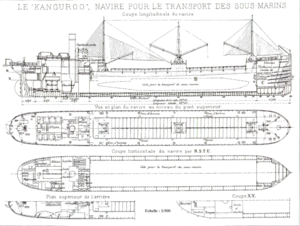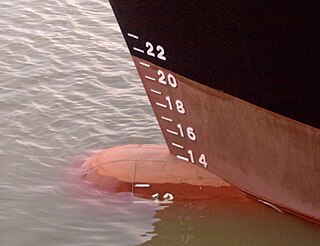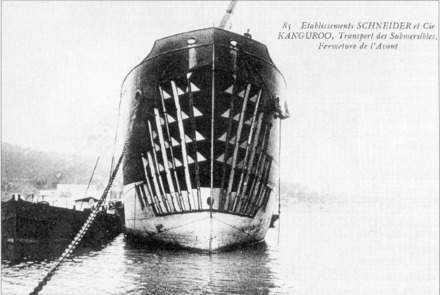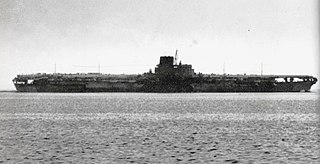
Shinano (信濃) was an aircraft carrier built by the Imperial Japanese Navy (IJN) during World War II, the largest such built up to that time. Laid down in May 1940 as the third of the Yamato-class battleships, Shinano's partially complete hull was ordered to be converted to a carrier following Japan's disastrous loss of four fleet carriers at the Battle of Midway in mid-1942. Her conversion was still not finished in November 1944 when she was ordered to sail from the Yokosuka Naval Arsenal to Kure Naval Base to complete fitting out and transfer a load of 50 Yokosuka MXY7 Ohka rocket-propelled kamikaze flying bombs. She was sunk en route, 10 days after commissioning, on 29 November 1944, by four torpedoes from the U.S. Navy submarine Archerfish. Over a thousand sailors and civilians were rescued and 1,435 were lost, including her captain. She remains the largest warship ever sunk by a submarine.
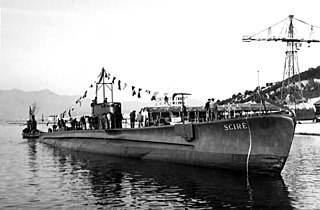
Italian submarine Scirè was an Adua-class submarine, built in 1930s which served during World War II in the Regia Marina. It was named after a northern region of Ethiopia, at the time part of Italian East Africa.

The Japanese submarine I-158 was a Kaidai-class cruiser submarine of the KD3A sub-class built for the Imperial Japanese Navy (IJN) during the 1920s. She supported Japanese forces during the invasion of Malaya in December 1941 and was instrumental in tracking Force Z, the two British capital ships that attempted to intercept the Japanese invasion forces, so they could be sunk by torpedo bombers.

German submarine U-51 was a Type VIIB U-boat of Nazi Germany's Kriegsmarine that operated during World War II. She was ordered in November 1936 and laid down in February 1937 in Kiel. She was launched in August 1939 and commissioned in November.
German submarine U-221 was a Type VIIC U-boat of Nazi Germany's Kriegsmarine during World War II.

German submarine U-66 was a Type IXC U-boat of Nazi Germany's Kriegsmarine during World War II. The submarine was laid down on 20 March 1940 at the AG Weser yard at Bremen, launched on 10 October and commissioned on 2 January 1941 under the command of Kapitänleutnant Richard Zapp as part of the 2nd U-boat Flotilla.

German submarine U-46 was a Type VIIB U-boat of Nazi Germany's Kriegsmarine during World War II. She had a highly successful career during the war.
German submarine U-564 was a Type VIIC U-boat built for Nazi Germany's Kriegsmarine for service during the Second World War. The RAF sank her in the Bay of Biscay on 14 June 1943.
German submarine U-77 was a Type VIIC U-boat of Nazi Germany's Kriegsmarine built by the Bremer Vulkan-Vegesacker Werft, Bremen-Vegesack. Her keel was laid down on 28 March 1940, by Bremer Vulkan of Bremen-Vegesack, Germany as yard number 5. She was launched on 23 November 1940 and commissioned on 18 January 1941, with Oberleutnant zur See Heinrich Schonder in command until September 1942, when he was succeeded by Oblt.z.S. Otto Hartmann, who remained in charge until the U-boat's loss.
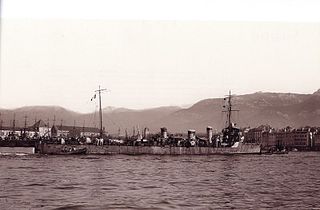
The Arabe-class destroyers was a group of twelve destroyers built for the French Navy during the First World War. All the ships were built in Japan, as an export version of the Kaba class, and were named after ethnic groups within the French Empire at the time.
SM U-41 was one of the 329 submarines serving in the Imperial German Navy in World War I. U-41 engaged in naval warfare and took part in the First Battle of the Atlantic.
Z13 Erich Koellner was a Type 1934A-class destroyer built for Nazi Germany's Kriegsmarine in the late 1930s. At the beginning of World War II, the ship was still working up. In early 1940 she made two successful minelaying sorties off the English coast that claimed six merchant ships. During the early stages of the Norwegian Campaign, Erich Koellner fought in both naval Battles of Narvik in mid-April 1940 and was severely damaged by British ships during the Second Battle of Narvik. The ship was scuttled by her crew shortly afterwards.
Archimede was a Brin-class submarine built for the Royal Italian Navy during the 1930s.
German submarine U-436 was a Type VIIC U-boat of Nazi Germany's Kriegsmarine during World War II.
German submarine U-576 was a Type VIIC U-boat of Nazi Germany's Kriegsmarine during World War II. She carried out five patrols, sinking four ships of 15,450 gross register tons (GRT) and damaging two more of 19,457 GRT. She was sunk in July 1942 by depth charges from two US aircraft and gunfire from a merchant ship, near the East Coast of the United States. The wreck was discovered in August 2014.

The French submarine Mariotte (Q74) was a submarine built for the French Navy prior to World War I. Intended to accompany the fleet, she was designed for high speed on the surface. Although the navy was unsatisfied with her performance on the surface, the boat had a higher underwater speed than any French submarine before or during the following 35 years. Mariotte was plagued with engine problems during her construction and the navy spent years fixing the various issues before finally commissioning her five years after beginning construction. During the war, she participated in the Dardanelles Campaign, but had to be scuttled after she became entangled in the cables of a minefield on her first attempt to penetrate the Dardanelles.
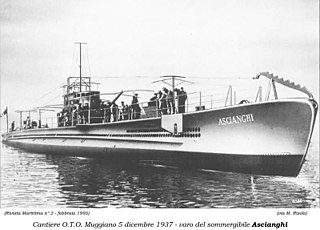
Italian submarine Ascianghi was an Adua-class submarine built for the Royal Italian Navy during the 1930s. It was named after Lake Ashenge in Ethiopia.
Japanese submarine I-181 was a Kaidai type cruiser submarine of the KD7 sub-class built for the Imperial Japanese Navy (IJN) during the 1940s. She was lost with all hands when she was ran aground in New Guinea after a battle with American ships in early 1944.
The Japanese submarine I-184 was a Kaidai type cruiser submarine of the KD7 sub-class built for the Imperial Japanese Navy (IJN) during the 1940s. She was sunk with all hands by an American torpedo bomber during the Battle of the Philippine Sea in mid-1944.
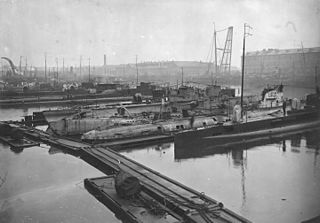
The Clorinde-class submarines were built for the French Navy prior to World War I. There were two boats in this class, neither of them would be used during World War I, but they operated in the Atlantic Ocean and the English Channel until they were stricken in 1926.
